Overview
The article outlines seven strategies for effective electrocardiogram (ECG) electrode placement, highlighting the significance of proper techniques, technology integration, and ongoing training for healthcare professionals. Key strategies encompass:
- Optimal skin preparation
- Patient positioning
- Utilization of advanced platforms such as MaxYield™, which enhance placement accuracy and signal quality
These improvements ultimately contribute to better diagnostic outcomes.
The MaxYield™ platform offers features that address common challenges in ECG analysis. By ensuring precise electrode placement, it minimizes artifacts and maximizes signal fidelity. This leads to clearer ECG readings, facilitating more accurate diagnoses. Furthermore, the platform's user-friendly interface allows healthcare professionals to quickly adapt to its functionalities, enhancing their overall efficiency during procedures.
Incorporating MaxYield™ into practice not only streamlines the ECG process but also provides significant advantages for healthcare professionals. Improved accuracy in electrode placement translates to higher quality data, which is crucial for effective patient management. As a result, healthcare providers can make informed decisions based on reliable ECG results, ultimately benefiting patient care.
Introduction
The accuracy of electrocardiogram (ECG) readings significantly impacts patient care; however, improper electrode placement continues to be a widespread challenge in clinical environments. The integration of advanced technologies, such as Neural Cloud Solutions' MaxYield™ platform, equips healthcare professionals with tools that enhance the precision of electrode positioning and streamline the entire ECG process.
Despite these innovations, a critical question arises: how can practitioners consistently implement best practices for electrode placement to prevent potentially critical diagnostic errors? This article examines seven key strategies that empower healthcare providers to optimize ECG electrode placement, ultimately leading to improved patient outcomes.
Neural Cloud Solutions: MaxYield™ for Enhanced ECG Electrode Placement Accuracy
The MaxYield™ platform from Neural Cloud Solutions revolutionizes ECG analysis by automating the electrocardiogram electrode placement process, which leads to significant improvements in accuracy and efficiency. This platform employs advanced algorithms that ensure optimal electrocardiogram electrode placement, thereby reducing the risk of misalignment that can compromise the precision of readings. One of its key features is the gold standard noise filtering, which enhances the clarity of ECG signals. Additionally, it streamlines workflows for healthcare professionals, enabling them to focus on patient care rather than manual adjustments.
MaxYield™ can analyze 200,000 heartbeats in under five minutes, highlighting its remarkable speed and efficiency. Studies indicate that the precision of electrocardiogram electrode placement has significantly improved, with automated systems yielding results comparable to traditional techniques. Cardiologists have recognized the integration of AI in electrocardiogram electrode placement as a transformative advancement, addressing a primary challenge in digital health—delivering clearer ECG signals in noisy, real-world settings.
This platform exemplifies how advanced algorithms can , ultimately resulting in improved patient outcomes and more reliable cardiac evaluations. The benefits of MaxYield™ extend beyond technical enhancements; they empower healthcare professionals to provide higher-quality care, ensuring that patients receive accurate and timely assessments.
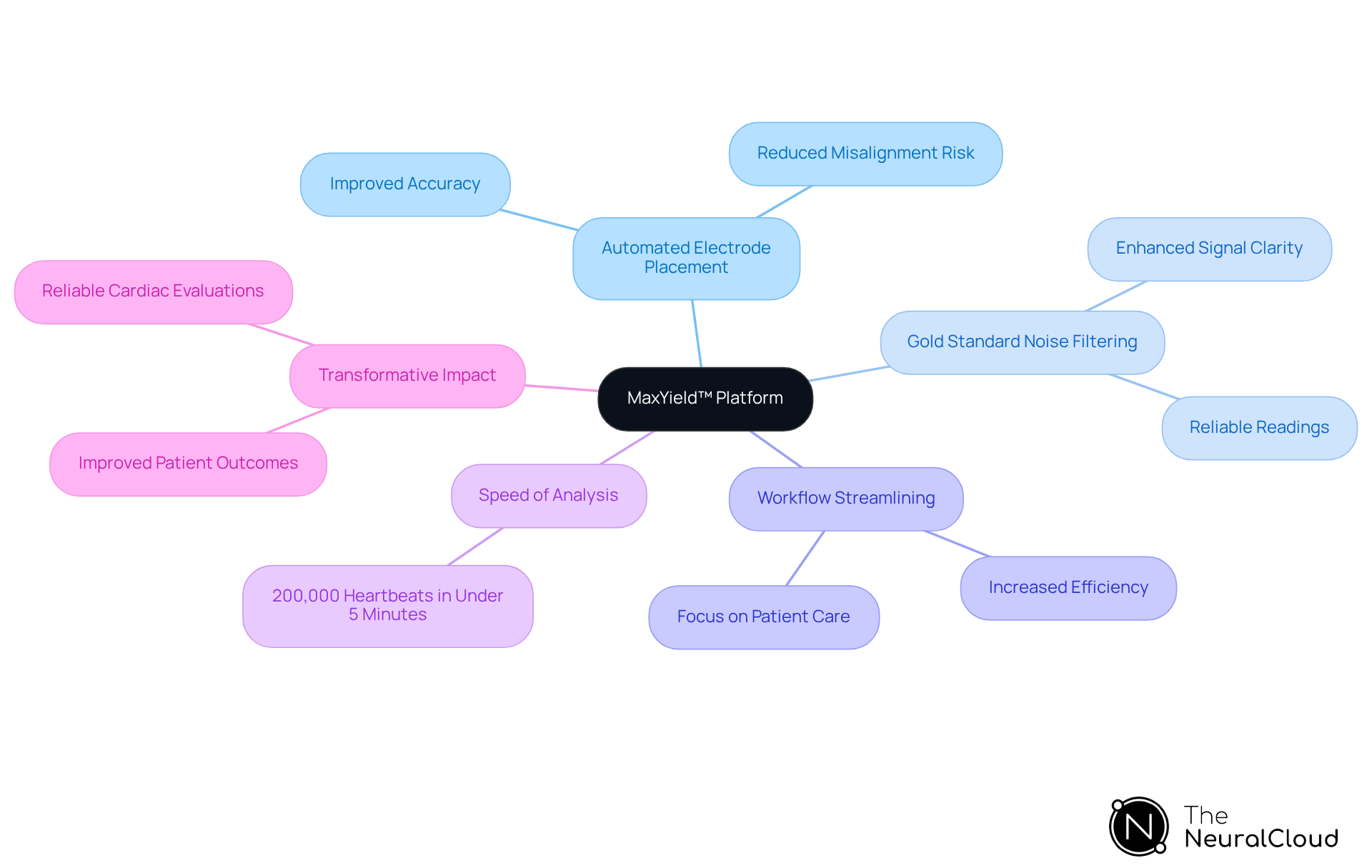
Understand Proper Electrode Placement Techniques for Accurate ECG Results
To obtain precise ECG outcomes, it is essential to adhere to established techniques for electrocardiogram electrode placement. The standard 12-lead ECG requires specific electrocardiogram electrode placement for both limb and chest leads. For instance, the electrocardiogram electrode placement for limb leads should be done on the wrists and ankles, while chest leads must be positioned according to anatomical landmarks, such as the Angle of Louis and the clavicular method. Healthcare professionals must be familiar with these techniques to ensure high-quality ECG data through proper electrocardiogram electrode placement.
Recent studies suggest that improper electrocardiogram electrode placement of sensors can lead to notable diagnostic mistakes, with up to 64% of nurses incorrectly positioning leads and fewer than 20% of cardiologists accurately placing V1 and V2 sensors. This highlights the necessity for ongoing training and adherence to guidelines to improve accuracy in assignments related to electrocardiogram electrode placement.
Successful applications of standard positioning techniques, particularly electrocardiogram electrode placement, in clinical environments have shown enhanced outcomes for individuals, emphasizing the significance of effective initial training and ongoing education. By ensuring proper electrocardiogram electrode placement, clinicians can minimize artifacts and enhance the reliability of ECG readings, ultimately leading to improved care for individuals.
Incorporating advanced solutions like Neural Cloud Solutions' MaxYield™ platform can further transform ECG analysis. With its capabilities in , MaxYield™ allows for the rapid isolation of ECG waves even in recordings affected by baseline wander and muscle artifacts. This adaptability not only improves diagnostic yield but also addresses the challenges posed by physiological variability and signal artifacts.
For effective implementation, health tech developers are encouraged to integrate training resources and guidelines that reinforce these best practices. Utilizing the innovative features of MaxYield™, such as automated labeling and neural network models, can significantly enhance ECG data processing and compliance.
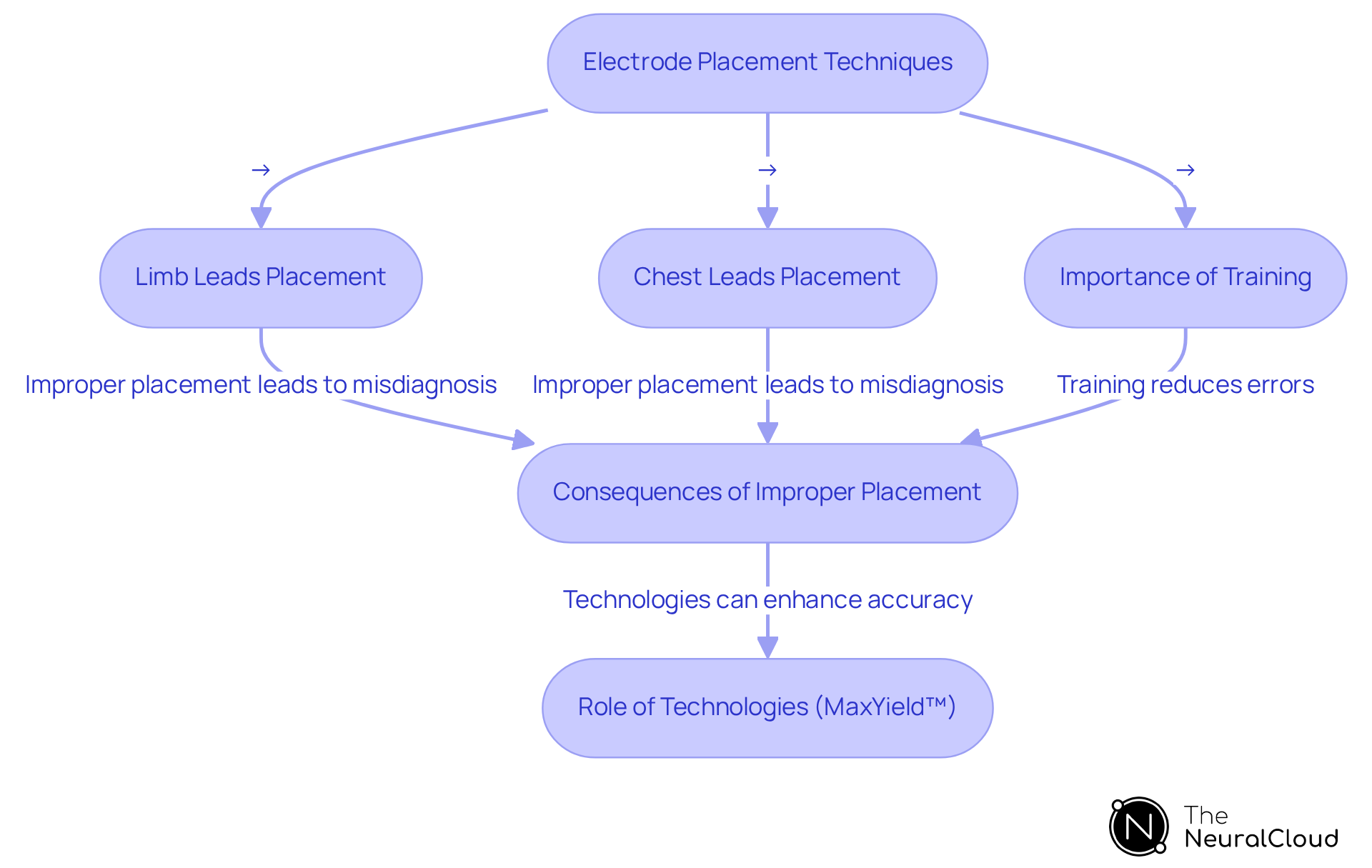
Overcome Common Challenges in ECG Electrode Placement
Challenges such as inadequate skin preparation, patient movement, and pad adhesion often hinder efficient electrocardiogram electrode placement. To achieve optimal adhesion and accurate readings, healthcare professionals must emphasize . This process includes cleansing the skin to eliminate oils, sweat, and dead cells, which can interfere with electrical signals. Research shows that proper skin preparation can decrease baseline and alarm noise by up to 75%, significantly improving ECG accuracy, which is essential for reliable diagnostics.
The use of sticky pads is vital for ensuring proper placement, especially during patient movement. These connectors are engineered to provide strong adhesion, which is critical for dependable readings. Additionally, training staff to manage patient anxiety can help minimize movement, further enhancing the accuracy of ECG results. For patients with sensitive skin, employing gentler preparation techniques and applying lighter pressure during pad placement can prevent irritation while ensuring effective device functionality. It is advisable to prolong the duration of rubbing during skin preparation to reduce discomfort.
Irregular electrocardiogram electrode placement remains a significant issue, with studies indicating that only 10% of healthcare professionals correctly position all ECG leads. This underscores the necessity for standardized training and strict adherence to established protocols regarding electrocardiogram electrode placement. By concentrating on these strategies, healthcare providers can improve the reliability of ECG readings. Moreover, integrating wearable technology with the MaxYield™ platform can automate the labeling process and enhance data accuracy. The platform's advanced noise filtering capabilities effectively tackle challenges such as baseline wander and muscle artifacts, ensuring that even recordings with substantial noise are accurately analyzed. Additionally, MaxYield™ can retrieve previously obscured segments of lengthy Holter, 1-Lead, and patch monitor recordings, resulting in better outcomes for patients and more efficient ECG data processing.

Optimize Patient Positioning for Effective ECG Electrode Placement
Proper client positioning is essential for achieving optimal electrocardiogram electrode placement. Ideally, individuals should be positioned supine, as this posture minimizes muscle tension and movement, which can interfere with the clarity of ECG signals. Studies indicate that muscle tension can significantly affect ECG readings, leading to potential misinterpretations. To further enhance signal quality, it is crucial to ensure that the individual is in a calm and quiet environment, reducing anxiety and cold extremities that may compromise the accuracy of the readings. Healthcare professionals emphasize that a calm individual, with arms comfortably at their sides, contributes to clearer and more reliable ECG results.
Integrating wearable technology with Neural Cloud Solutions' MaxYield™ platform allows healthcare providers to automate ECG labeling and data extraction. This automation significantly reduces operational costs while enhancing analysis efficiency. The MaxYield™ platform's AI-powered algorithms ensure smooth signals when analyzing and annotating abnormal electrocardiograms, which is vital for accurate diagnostics. As noted by experts, while supine positioning is preferred, alternative positions like Fowler's may be necessary in acute cases where comfort is a concern.
Ultimately, prioritizing comfort and minimizing external stressors, such as anxiety and cold extremities, are key strategies for and signal acquisition. Always ensure the patient is in a comfortable position and minimize external distractions to enhance ECG signal quality.
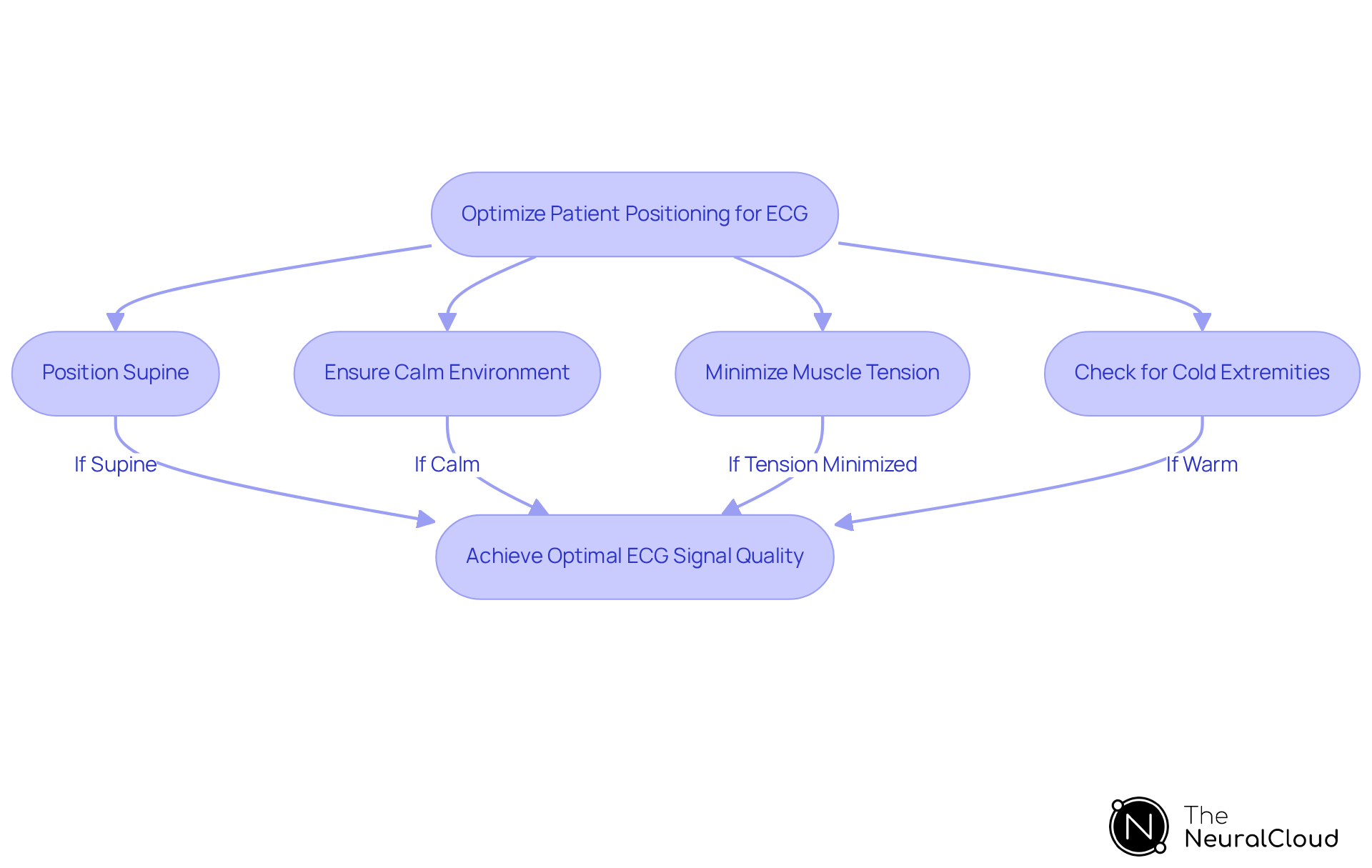
Prepare Skin Properly to Enhance ECG Signal Quality
Proper skin preparation is crucial for enhancing ECG signal quality. Cleaning the skin with alcohol wipes effectively removes oils and dirt that can hinder adhesion and signal transmission. Techniques such as using isopropyl alcohol and gently abrading the skin can significantly improve conductivity. Research indicates that effective skin preparation leads to clearer ECG signals and enhances the reliability of the data collected, ultimately supporting better clinical decision-making.
Integrating wearable technology with MaxYield™ further optimizes this process by automating the labeling of ECG waves and utilizing advanced noise filtering capabilities. MaxYield™ can salvage previously obscured sections of recordings, ensuring that even in challenging conditions, the diagnostic yield is maximized while reducing costs. This not only improves the but also streamlines the workflow for healthcare professionals, allowing for more accurate and timely diagnoses.
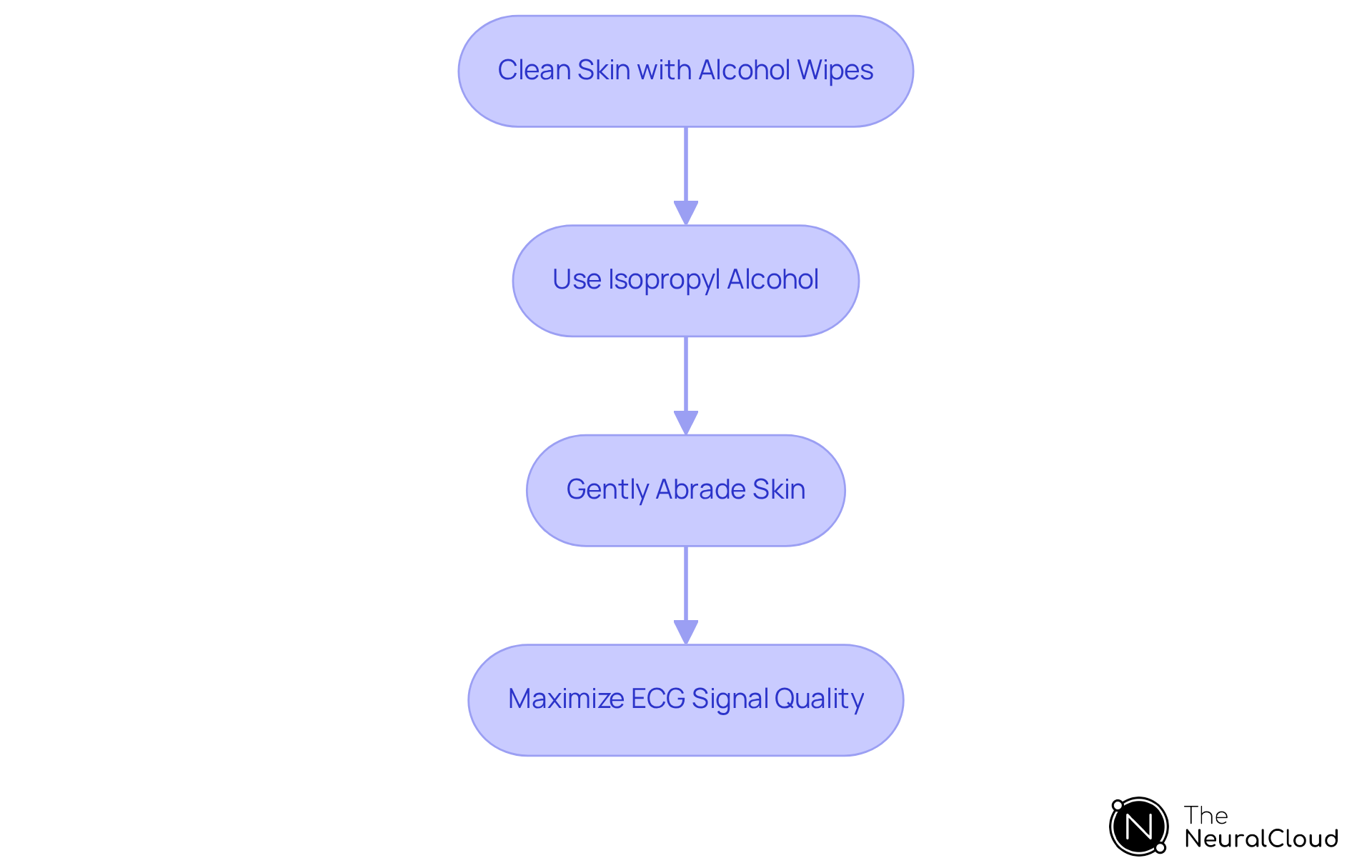
Select High-Quality Electrodes for Reliable ECG Measurements
Choosing high-quality conductors is essential for obtaining reliable ECG readings, especially when utilizing advanced technologies like Neural Cloud Solutions' MaxYield™ platform. Healthcare professionals should prioritize sensors that ensure good adhesion, low impedance, and compatibility with ECG machines. Single-use, pre-gelled sensors are often preferred due to their convenience and effectiveness. By investing in high-quality components, practitioners can significantly improve the accuracy and reliability of ECG readings, particularly in challenging environments where noise and signal artifacts may obscure critical information.
The MaxYield™ platform offers advanced noise filtering and distinct wave recognition capabilities, which enhance the diagnostic yield. These features ensure that even recordings affected by can be effectively analyzed. By addressing the challenges in ECG analysis, the platform empowers healthcare professionals to obtain clearer insights from their data, ultimately leading to better patient outcomes.
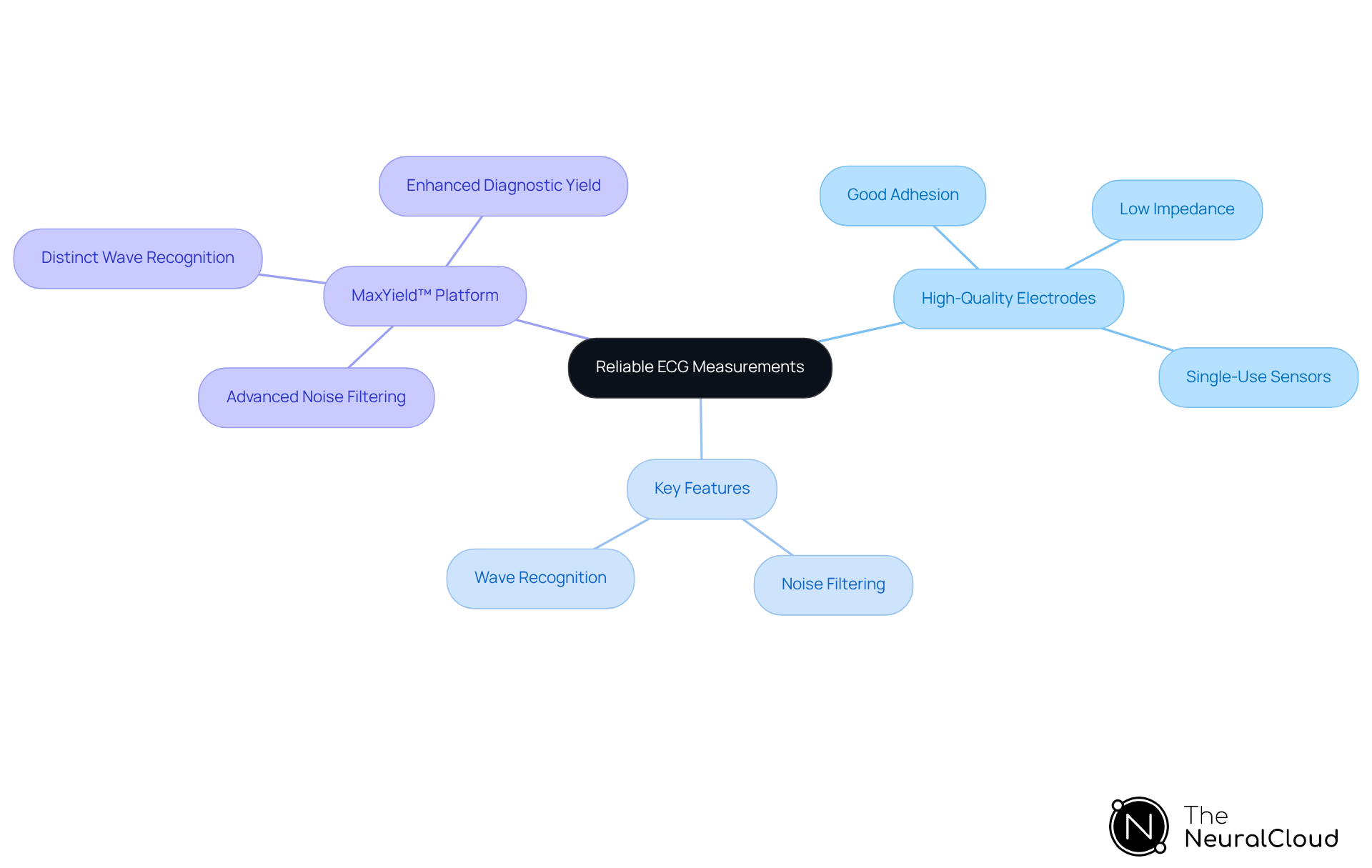
Ensure Continuous Training for Healthcare Professionals in ECG Techniques
To ensure effective electrocardiogram electrode placement, healthcare professionals must engage in continuous training. Regular workshops, online courses, and hands-on practice help staff stay updated on the latest techniques and technologies. This includes the integration of with Neural Cloud Solutions' MaxYield™ for automated labeling. Such continuous education enhances individual skills and contributes to overall improvements in care and diagnostic accuracy.
Research indicates that structured training programs, such as the AACN Basic ECG Interpretation course providing 6.5 continuing nursing education contact hours, can significantly enhance ECG interpretation skills, which are essential for precise assessments. Healthcare instructors emphasize that ongoing training is directly linked to improved precision in electrocardiogram electrode placement, ultimately resulting in enhanced outcomes for patients. As Mark Warmbrand, head of AACN’s technology-driven learning initiatives, states, "We keep enriching our E-Learning library with the latest, evidence-based information to support and improve clinical practice and optimize outcomes for those receiving care."
The support of Neural Cloud Solutions' Continuous Learning Model, which evolves with each use to enhance accuracy and efficiency, underscores the critical importance of continuous education in ECG practices. The algorithm's ability to adapt and improve with each application ensures that healthcare professionals are equipped with the most effective tools for ECG analysis. This ultimately benefits patient care, reinforcing the value of ongoing training and education in the healthcare field.
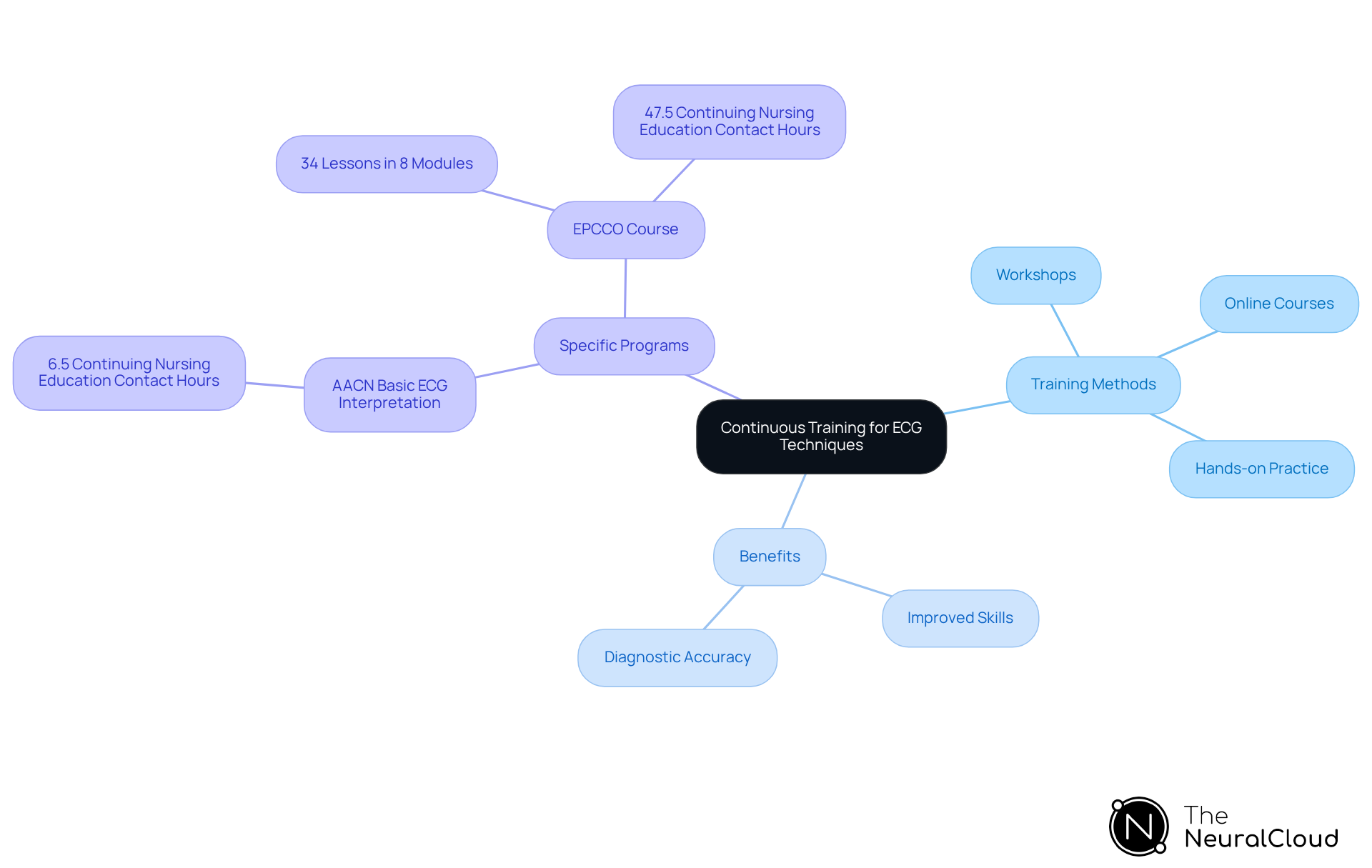
Study Relevant Anatomy for Effective ECG Electrode Placement
A comprehensive understanding of cardiac anatomy is essential for effective electrocardiogram electrode placement. Healthcare professionals must become acquainted with the electrocardiogram electrode placement for key cardiac structures, such as the heart's chambers and valves, to ensure correct sensor positioning. Research shows that awareness of anatomical landmarks greatly correlates with enhanced ECG accuracy, which is vital for correct electrocardiogram electrode placement, resulting in more dependable readings and improved outcomes for individuals. For instance, studies indicate that incorrect electrocardiogram electrode placement can lead to misinterpretation of cardiac conditions, highlighting the necessity for accurate device positioning. Anatomists emphasize that accurate identification of anatomical features is crucial for clinicians, as it directly impacts the quality of ECG data and the effectiveness of electrocardiogram electrode placement. By mastering these anatomical details, healthcare providers can enhance their ECG interpretation skills, particularly in relation to electrocardiogram electrode placement, ultimately improving patient care.
Furthermore, integrating wearable technology with MaxYield™ automates the labeling process, significantly reducing costs while enhancing analysis efficiency. MaxYield™ features advanced noise filtering and wave recognition capabilities that allow for the isolation of critical ECG waves. This technology assists in affected by noise and artifacts. As a result, healthcare professionals can rely on precise data, directly linking their anatomical knowledge to improved diagnostic outcomes.
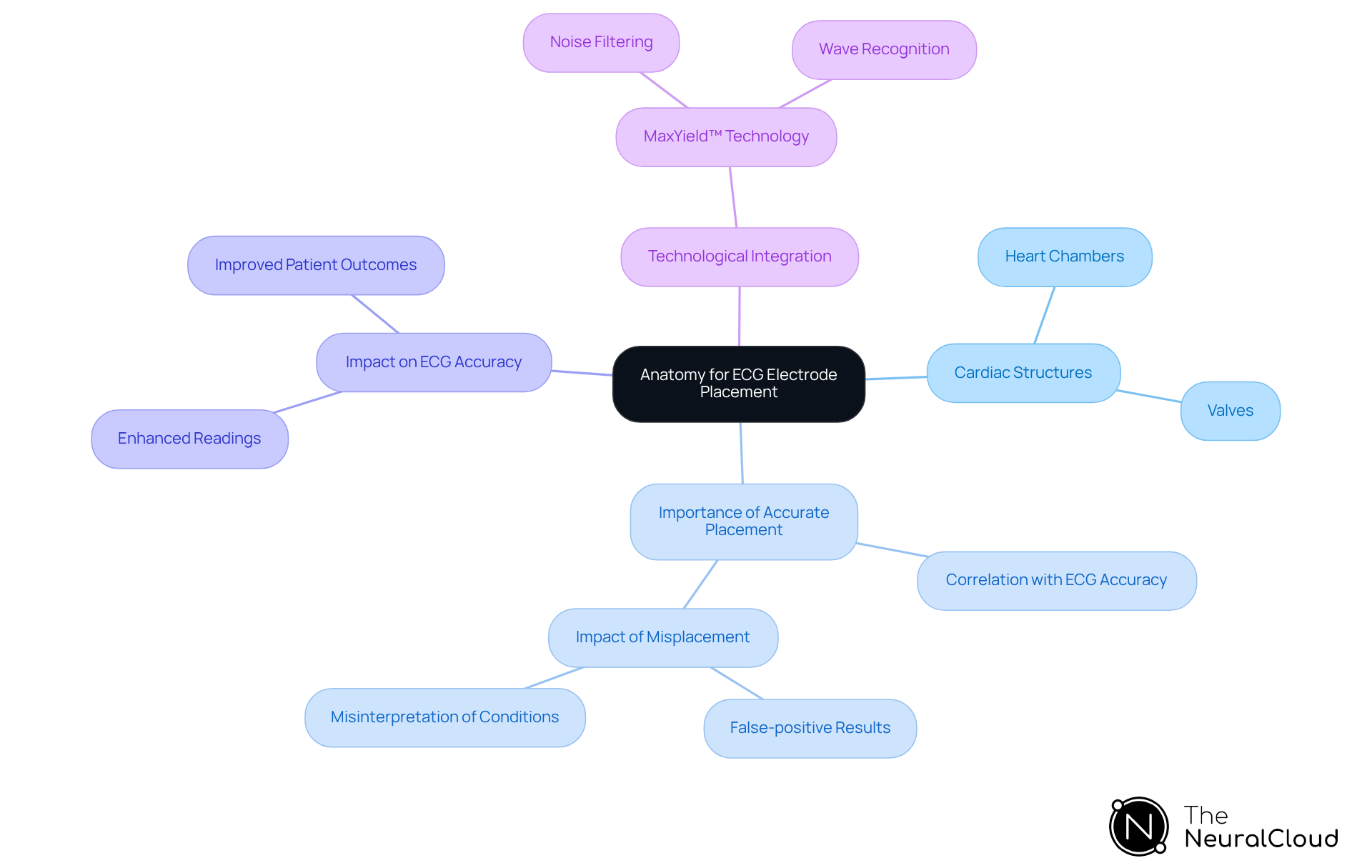
Utilize Technology to Optimize ECG Electrode Placement
The challenges in ECG analysis often stem from improper electrocardiogram electrode placement, which can compromise the accuracy of results. Utilizing , such as Neural Cloud Solutions' MaxYield™ platform, significantly improves the precision of ECG lead positioning. This platform employs gold standard methodologies to provide real-time feedback on both probe positioning and signal quality. Such prompt guidance enables healthcare professionals to make necessary adjustments, ensuring optimal positioning for superior signal acquisition.
The integration of MaxYield™ streamlines the ECG process and enhances patient assessment accuracy. By automating repetitive tasks and processing more data in less time, the platform allows healthcare professionals to focus on critical decision-making. Proper positioning of lead V is particularly crucial for the accuracy of electrocardiogram electrode placement, as it enhances the probability of precise alignment for other electrodes. This highlights the essential function of real-time feedback systems in attaining dependable ECG outcomes.
As the field of ECG technology continues to evolve, tech developers emphasize that advancements like those offered by Neural Cloud Solutions are vital for enhancing clinical outcomes and operational efficiency. Enhanced initial and refresher training should concentrate on identifying landmarks and ensuring proper positioning of lead V, highlighting the importance of electrocardiogram electrode placement, as incorrect arrangements can alter the morphology of the ECG and impact patient treatment.
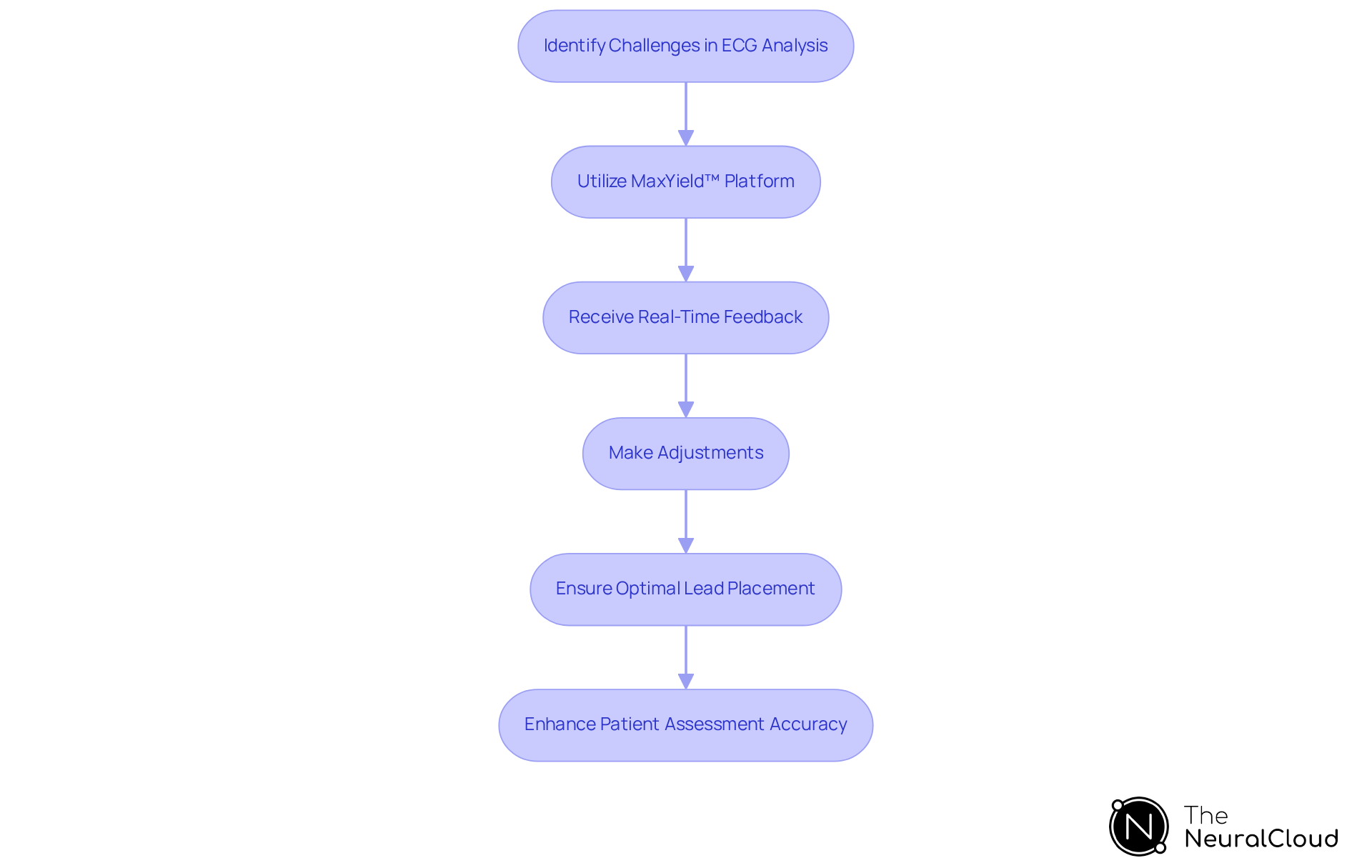
Implement Post-Placement Verification for Accurate ECG Readings
Implementing post-placement verification is essential for ensuring accurate ECG readings. After positioning the sensors, healthcare professionals must evaluate the signal quality and confirm that the sensors are securely attached. This is critical, as it can identify potential issues before the ECG recording begins, significantly reducing the likelihood of errors.
Research indicates that effective verification methods can lead to a marked decrease in ECG errors, thereby enhancing the reliability of the data collected. Cardiologists emphasize that meticulous verification of electrocardiogram electrode placement is vital for obtaining actionable insights from ECG readings, reinforcing the necessity of this critical step in the ECG process.

Conclusion
The effective placement of electrocardiogram (ECG) electrodes is crucial for obtaining accurate and reliable cardiac assessments. Integrating advanced technologies, such as Neural Cloud Solutions' MaxYield™ platform, significantly enhances the precision of electrode positioning, ultimately improving patient outcomes. Emphasizing proper techniques, continuous training, and high-quality electrodes contributes to the reliability of ECG readings, ensuring clinicians can make informed decisions based on clear and accurate data.
Key strategies highlighted throughout this discussion include:
- Understanding anatomical landmarks
- Proper skin preparation
- The necessity of post-placement verification
These practices reduce the likelihood of diagnostic errors and empower healthcare providers to deliver higher-quality care. Furthermore, the integration of AI-driven solutions like MaxYield™ streamlines workflows, allowing professionals to focus more on patient care rather than manual adjustments.
As the landscape of ECG technology continues to evolve, the commitment to ongoing education and the adoption of innovative tools will be essential. By prioritizing these strategies and embracing advancements in technology, healthcare professionals can enhance the accuracy and efficacy of ECG assessments, ultimately leading to better patient care and improved clinical outcomes.
Frequently Asked Questions
What is the MaxYield™ platform and how does it enhance ECG analysis?
The MaxYield™ platform from Neural Cloud Solutions automates the electrocardiogram (ECG) electrode placement process, improving accuracy and efficiency. It uses advanced algorithms for optimal electrode placement, reducing misalignment risks and enhancing signal clarity with gold standard noise filtering.
How quickly can MaxYield™ analyze heartbeats?
MaxYield™ can analyze 200,000 heartbeats in under five minutes, showcasing its remarkable speed and efficiency.
What improvements have studies shown regarding electrode placement accuracy with MaxYield™?
Studies indicate that the precision of electrocardiogram electrode placement has significantly improved with automated systems, yielding results comparable to traditional techniques.
Why is proper electrode placement critical for accurate ECG results?
Proper electrode placement is essential as improper placement can lead to diagnostic mistakes. Studies show that up to 64% of nurses incorrectly position leads, which emphasizes the need for ongoing training and adherence to established guidelines.
What are common challenges faced during ECG electrode placement?
Common challenges include inadequate skin preparation, patient movement, and pad adhesion, which can hinder accurate readings. Proper skin cleansing and the use of sticky pads are vital for ensuring effective electrode placement.
How can healthcare professionals improve the reliability of ECG readings?
Healthcare professionals can improve reliability by emphasizing thorough skin preparation, managing patient anxiety to minimize movement, and adhering to standardized training protocols for electrode placement.
What role does the MaxYield™ platform play in addressing ECG analysis challenges?
The MaxYield™ platform enhances ECG analysis by providing advanced noise filtering capabilities, automating the labeling process, and effectively analyzing recordings affected by noise, leading to improved diagnostic yield and patient outcomes.
What should health tech developers consider for effective ECG electrode placement training?
Health tech developers are encouraged to integrate training resources and guidelines that reinforce best practices for electrode placement, utilizing features of MaxYield™ to enhance ECG data processing and compliance.






